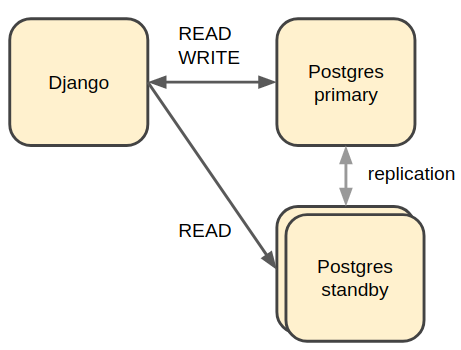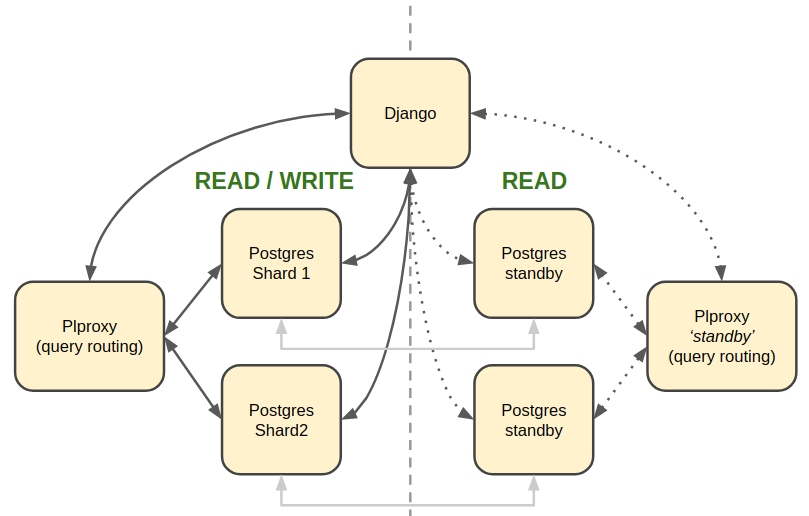Configuring SQL Databases in CommCare
CommCare makes use of a number of logically different SQL databases. These databases can be all be a single physical database or configured as individual databases.
By default CommCare will use the default Django database for all SQL data.

Auditcare Data
Auditcare data may be stored in a separate database by specifying a mapping in the LOCAL_CUSTOM_DB_ROUTING setting. A database with the specified alias must also exist in the Django DATABASES setting. Example configuration:
LOCAL_CUSTOM_DB_ROUTING = {"auditcare": "auditcare"}
It is recommended to use a separate database in high-traffic environments when auditcare is enabled. Auditcare is enabled for a subset of URLs by default.
Synclog Data
Synclog data may be stored in a separate database specified by the SYNCLOGS_SQL_DB_ALIAS setting. The value of this setting must be a DB alias in the Django DATABASES setting.
UCR Data
Data created by the UCR framework can be stored in multiple separate databases. Each UCR defines an engine_id parameter which tells it which configured database engine to use. These engines are defined in the REPORTING_DATABASES Django setting which maps the engine_id to a Django database alias defined in the DATABASES setting.
REPORTING_DATABASES = {
'default': 'default',
'ucr': 'ucr'
}
Sending read queries to standby databases
By including details for standby databases in the Django DATABASES setting we can configure CommCare to route certain READ queries to them.
Standby databases are configured in the same way as normal databases but may have an additional property group, STANDBY. This property group has the following sup-properties:
- MASTER
The DB alias of the master database for this standby. This must refer to a database in the DATABASES setting.
- ACCEPTABLE_REPLICATION_DELAY
The value of this must be an integer and configures the acceptable replication delay in seconds between the standby and the master. If the replication delay goes above this value then queries will not be routed to this database.
The default value for ACCEPTABLE_REPLICATION_DELAY is 3 seconds.
DATABASES = {
'default': {...}
'standby1': {
...
'STANDBY': {
'MASTER': 'default',
'ACCEPTABLE_REPLICATION_DELAY': 30,
}
}
}
Once the standby databases are configured in the DATABASES settings there are two additional settings that control which queries get routed to them.
REPORTING_DATABASES
The REPORTING_DATABASES setting can be updated as follows:
REPORTING_DATABASES = {
'default': 'default',
'ucr': {
'WRITE': 'ucr',
'READ': [
('ucr', 1),
('ucr_standby1', 2),
('ucr_standby2', 2),
]
}
}
The tuples listed under the ‘READ’ key specify a database alias (must be in DATABASES) and weighting. In the configuration above 20% of reads will be sent to ucr and 40% each to ucr_standby1 and ucr_standby2 (assuming both of them are available and have replication delay within range).
LOAD_BALANCED_APPS
This setting is used to route read queries from Django models.
LOAD_BALANCED_APPS = {
'users': {
'WRITE': 'default',
'READ': [
('default', 1),
('standby1', 4),
]
}
}
In the configuration above all write queries from models in the users app will go to the default database as well as 20% or read queries. The remaining 80% of read queries will be sent to the standby1 database.
For both the settings above, the following rules apply to the databases listed under READ:
There can only be one master database (not a standby database)
All standby databases must point to the same master database
If a master database is in this list, all standbys must point to this master
Using standbys with the plproxy cluster
The plproxy cluster needs some special attention since the queries are routed by plproxy and not by Django. In order to do this routing there are a number of additional pieces that are needed:
1. Separate plproxy cluster configuration which points the shards to the appropriate standby node instead of the primary node. 2. Duplicate SQL functions that make use of this new plproxy cluster.
In order to maintain the SQL function naming the new plproxy cluster must be in a separate database.

Example usage
# this will connect to the shard standby node directly
case = CommCareCase.objects.partitioned_get(case_id)
# this will call the `get_cases_by_id` function on the 'standby' proxy which in turn
# will query the shard standby nodes
cases = CommCareCase.objects.get_cases(case_ids, domain)
These examples assume the standby routing is active as described in the Routing queries to standbys section below.
Steps to setup
Add all the standby shard databases to the Django DATABASES setting as described above.
2. Create a new database for the standby plproxy cluster configuration and SQL accessor functions and add it to DATABASES as shown below:
DATABASES = {
'proxy_standby': {
...
'PLPROXY': {
'PROXY_FOR_STANDBYS': True
}
}
}
Run the configure_pl_proxy_cluster management command to create the config on the ‘standby’ database.
Run the Django migrations to create the tables and SQL functions in the new standby proxy database.
Routing queries to standbys
The configuration above makes it possible to use the standby databases however in order to actually route queries to them the DB router must be told to do so. This can be done it one of two ways:
Via an environment variable
export READ_FROM_PLPROXY_STANDBYS=1
This will route ALL read queries to the shard standbys. This is mostly useful when running a process like pillowtop that does is asynchronous.
Via a Django decorator / context manager
# context manager
with read_from_plproxy_standbys():
case = CommCareCase.objects.partitioned_get(case_id)
# decorator
@read_from_plproxy_standbys()
def get_case_from_standby(case_id)
return CommCareCase.objects.partitioned_get(case_id)
